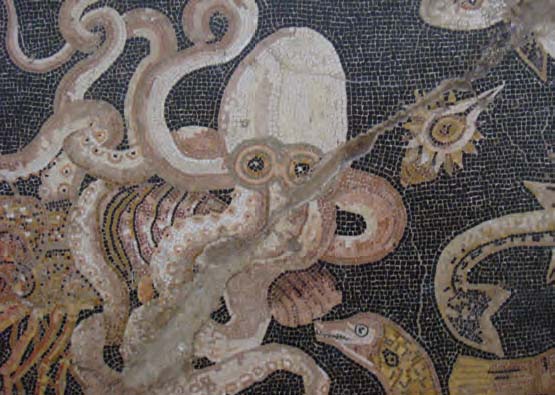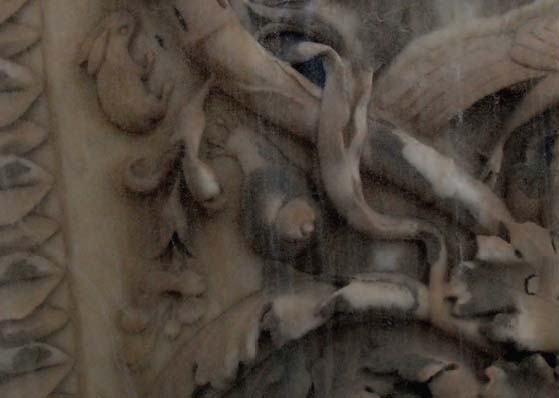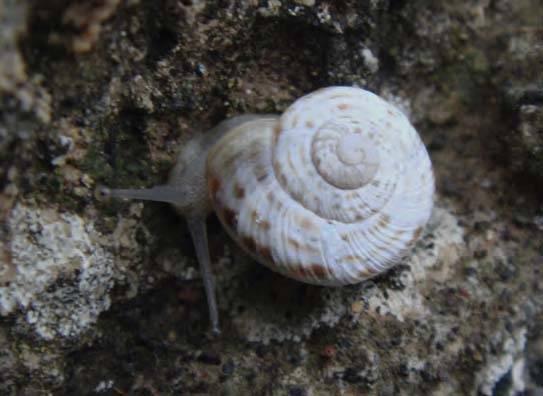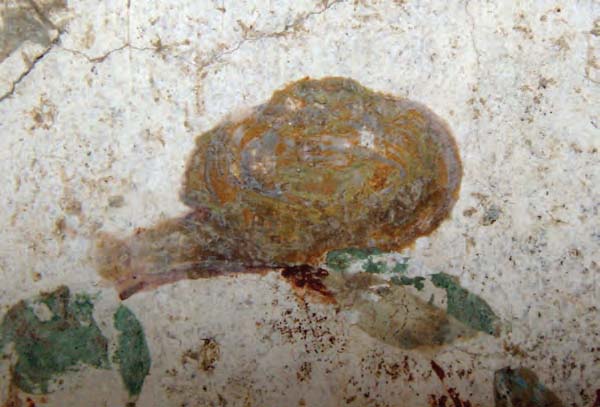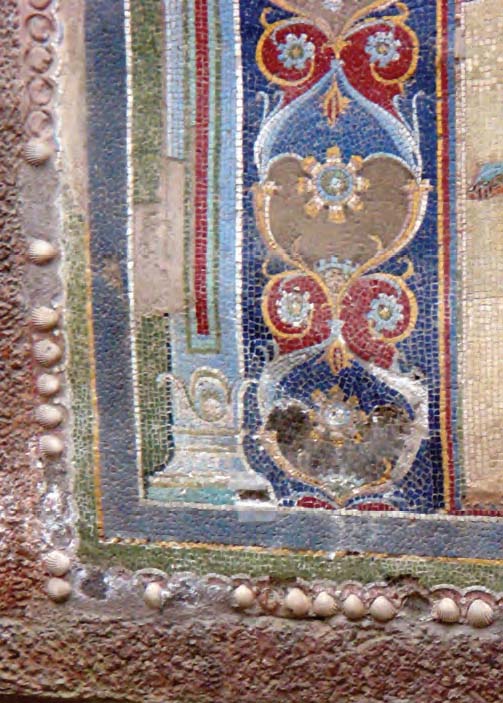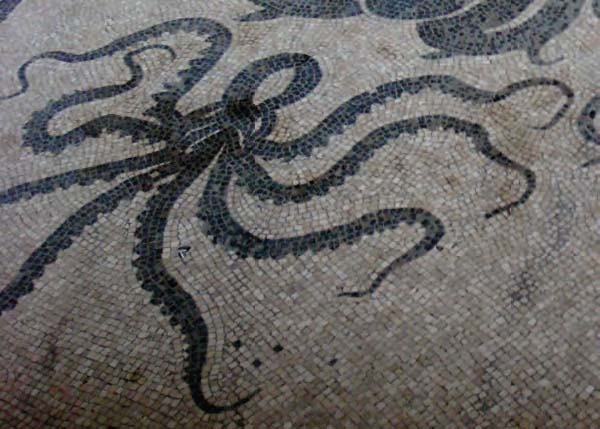|
The archeological sites of the Naples area are well known through their high state of preservation associated with their destruction in the eruption of Vesuvius in AD79. On a visit in October 2008 I was interested to see that there were ancient images of molluscs depicted in mosaics, sculpture and painting as well as examples of the decorative use of shells themselves. The use of molluscs by the ancient civilisations of the Mediterranean has been well documented and it is not my intention to detail these here; merely to illustrate some examples of their depiction. Pompei was the earliest site there to be excavated (from the 18th century onwards) and many examples of mosaics and sculpture from this Roman town are in the National Archeological Museum in Naples. Monumental mosaics from the “House of the Faun” which have an “Alexandrian” theme include an emblematic mosaic of Nilotic ducks with lotus flowers in their beaks above stylised scallop and “Murex” shells (photo 1) and a mosaic of marine life with a depiction of a lobster capturing an octopus (photo 2)! Near the temple of Vespasian is an example of very fine “nature carving” (protected under a modern plastic cover which hampers visibility) that includes lifelike depictions of land snails (photo 3) that may have been meant to depict one of the Helicid species still found in the area today, such as Eobania vermiculata (Muller, 1774) or Marmorana fuscolabiata (Rossmassler, 1842) (photo 4) both of which I found on the walls of some of the buildings. The “Villa Poppea” at Oplontis, a short distance from Pompei near to the coast was unoccupied at the time of the eruption and by all accounts at the time was in the process of being repaired and redecorated following one of the earthquakes common in the area. The wall paintings here are exquisite and depict architectural designs as well as paintings of birds, masks and flowers. Amongst the wall paintings of the “Third” or “ornamental” style which was used until the first half of the 1st century A.D., are delicate depictions of insects (e.g. grasshoppers, butterflies) and also snails (photo 5) of a similar type depicted in the Pompei sculptural decorations. Unlike Pompei, engulfed by ash falls, the town of Herculaneum on the opposite side of Vesuvius was buried under 12 metres of hardened mud from the pyroclastic flow that engulfed the town. Whilst this has made excavations much more difficult, the state of preservation is thus greater and there are survivals of wood, including a bed, a wooden screen and even examples of rope and fabric. In the “House of Neptune and Amphitrite” a mosaic depicting the god and goddess is still bordered by Cerastoderma shells, somewhat reminiscent of modern shell grottos (photo 6). The floor of the central baths here is decorated with marine life including squid and octopus (photo 7). There is ample evidence from Pompei and other sites that the Romans were keen consumers of marine molluscs. Their shells have been found in excavations of food shops. The ability to extract the purple dye produced by “Murex” species gave birth to an industry which originated in the Phoenician culture of the eastern part of the Mediterranean. So is there the possibility that the depictions of “Murex” (possibly Bolinus brandaris (Linnaeus, 1758)?) in the “Alexandrian” mosaics from Pompei are references to Alexander’s conquest of the Phoenician city of Tyre in 332B.C.? Both Pompei and Herculaneum were “port towns” which at the time had access to the sea, however it appears that sculptors and artists were also keen observers of non-marine life, including snails. In the two centuries preceding the A.D.79 eruption of Vesuvius the depiction of molluscs in the decoration of Roman houses and public buildings are indications of their importance in the culture of that time. ReferencesCappelli, R. Quick Guide: National Archeological Museum of Naples. Naples, 1999 Jackson, J.W. Shells as Evidence of the Migrations of Early Culture. University of Manchester Press, 1917 Pinto-Guillaume, E.M. Molluscs from Regio V, Insula 1 at Pompeii: a preliminary report. Archaeo Malac. Grp. Newsletter 11 2007 |
Photograph 1
Photograph 2
Photograph 3
Photograph 4
Photograph 5
Photograph 6
Photograph 7 |
Molluscs in Roman art: the archeological sites of the Naples area, Italy
Issue
16
Page
19


